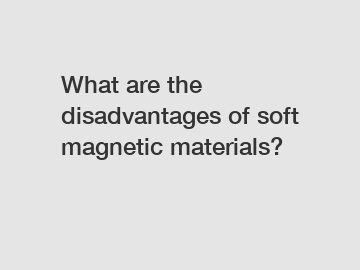What are the disadvantages of soft magnetic materials?
Soft magnetic materials are crucial components in a wide range of applications, from electric motors to transformers. These materials are valued for their ability to magnetize and demagnetize easily, making them ideal for converting electrical energy into mechanical energy and vice versa. However, despite their many advantages, soft magnetic materials also have some disadvantages that need to be considered when choosing the right material for a specific application. In this article, we will explore some of the drawbacks of soft magnetic materials.
Cost.
One of the main disadvantages of soft magnetic materials is their cost. Soft magnetic materials, such as silicon steel and iron-nickel alloys, can be more expensive than other types of materials, such as hard magnetic materials or even non-magnetic materials. This higher cost can make soft magnetic materials less attractive for some applications, especially those with strict budget constraints.

Saturation.
Soft magnetic materials have a saturation point, beyond which they can no longer effectively magnetize. This saturation limit can restrict the amount of energy that can be stored or transferred in a magnetic field. In applications where high magnetic fields are required, such as in power transformers or high-speed motors, this limitation can be a significant disadvantage.
Hysteresis losses.
Soft magnetic materials exhibit hysteresis, which means that there is a loss of energy when the material is magnetized and demagnetized. This hysteresis loss leads to inefficiencies in energy conversion applications, where energy is lost as heat during each magnetic cycle. In high-frequency applications, such as inductors for power supplies or transformers in electronics, hysteresis losses can result in decreased overall efficiency.
Curie temperature.
Soft magnetic materials have a critical temperature known as the Curie temperature, above which they lose their magnetic properties. This limitation can be a disadvantage in applications where high operating temperatures are required, as the material may lose its magnetic properties and become ineffective. This makes soft magnetic materials unsuitable for use in high-temperature environments, such as in certain industrial or automotive applications.
Mechanical properties.
Soft magnetic materials are often not as mechanically strong as other types of materials, such as structural steels or aluminum alloys. This lower mechanical strength can limit the use of soft magnetic materials in applications where the material is subjected to significant stresses or mechanical loads. In high-power electromechanical devices, such as loudspeakers or actuators, the mechanical properties of soft magnetic materials can be a drawback.
Conclusion.
While soft magnetic materials offer many benefits in terms of magnetization properties and energy conversion efficiency, they also have some disadvantages that need to be carefully considered. Factors such as cost, saturation limits, hysteresis losses, Curie temperature, and mechanical properties can all impact the performance and suitability of soft magnetic materials for specific applications. By understanding these drawbacks and their implications, engineers and designers can make informed decisions when selecting soft magnetic materials for their projects.
In conclusion, while soft magnetic materials have drawbacks, they remain essential components in numerous applications. If you have any questions or need further information about soft magnetic materials, please do not hesitate to contact us.
Contact us to discuss your requirements of Fecral Alloy Bar, Pure Metal, Low Resistance Heating Alloy. Our experienced sales team can help you identify the options that best suit your needs.
150
0
0


Comments
All Comments (0)